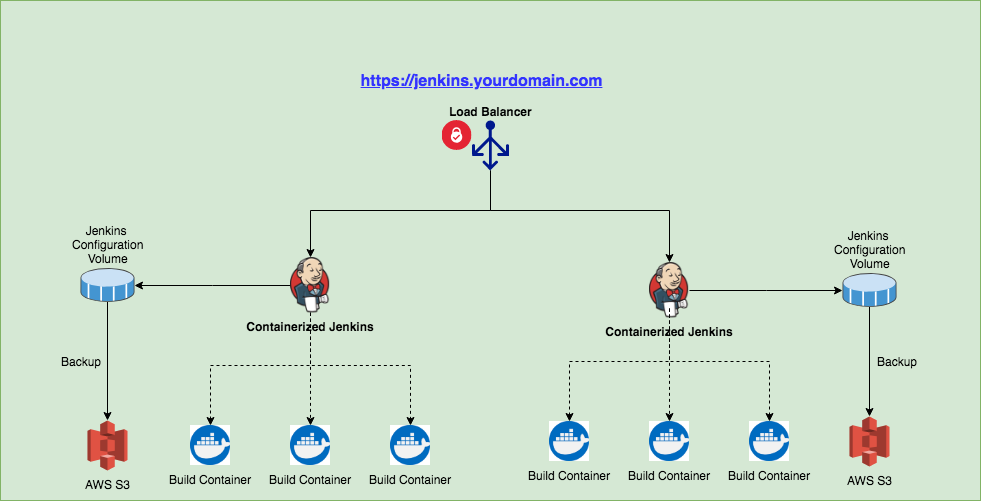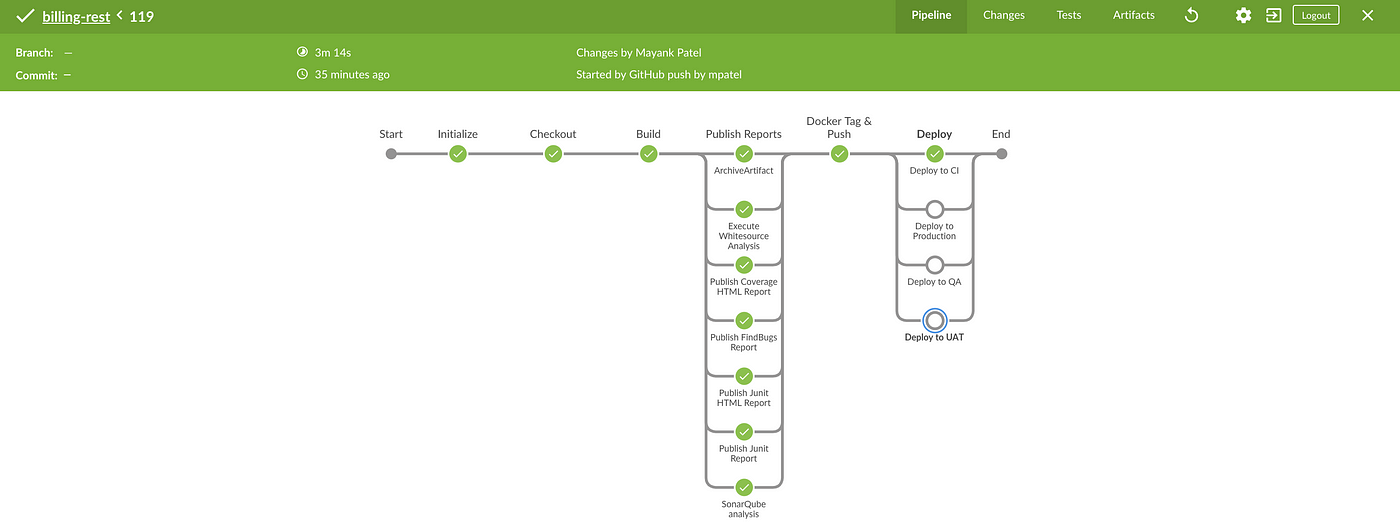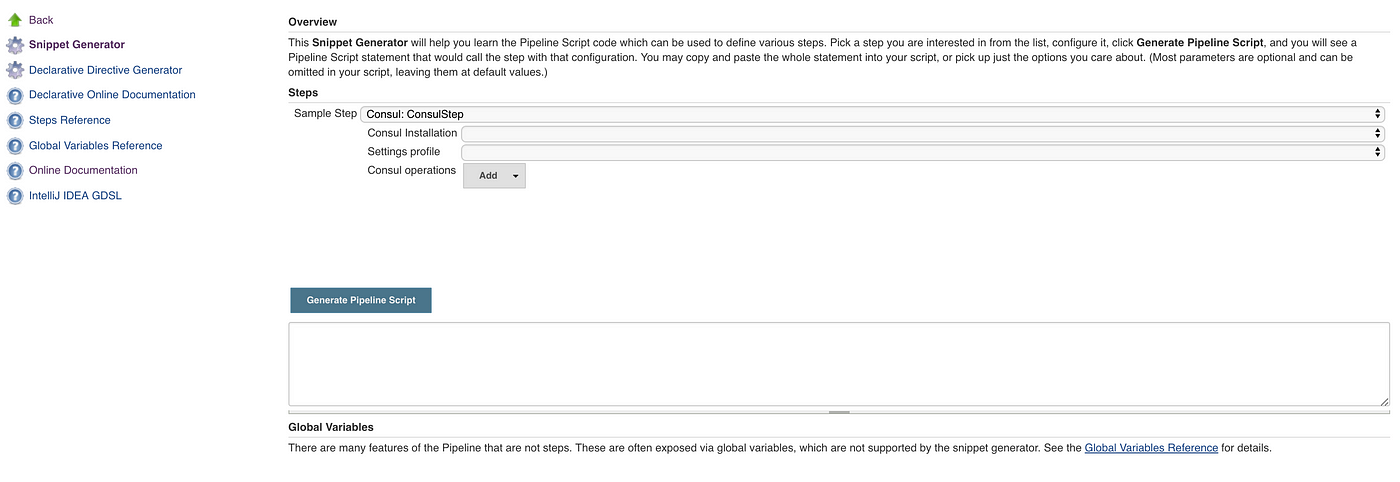Pipeline as a Code using Jenkins 2
About Me: Application Architect at Oildex, a Services of Transzap Inc,.
The missing link to your DevOps culture is Continuous Integration / Continuous Delivery pipeline. If you are in the market looking to implement pipeline using OpenSource solution then Jenkins is your friend. Revamped Jenkins 2 has a main focus on Developer experience to create pipelines programmatically.
What we will be covering in this post:
- Overview of Jenkins 2
- Jenkins Pipeline Features
- Jenkins Deployment/Environment
- Ideal Pipeline Flow
- Important pipeline plugins
- Jenkins Pipeline Example
Overview of Jenkins 2
- Built-in support for delivery pipelines.
- Improved usability.
- Fully backward compatible.
Jenkins Pipeline Features
- Can support complex, real-world, CD Pipeline requirements: pipelines can fork/join, loop, parallel, to name a few programmatically
- Is Resilient: pipeline executions can survive master restarts
- Is Pausable: pipelines can pause and wait for human input/approval
- Is Efficient: pipelines can restart from saved checkpoints
- Is Visualized: Pipeline StageView provides status at-a-glance dashboards including trending
- Pipeline configuration as a code in source control
- Ability to embed Security part of DevOps pipeline
- Reusability
- Easy Recoverability
Jenkins Deployment/Environment

For your OpenSource or Enterprise organization projects you should have a scalable Jenkins environment. Most common practices for Jenkins environment so far has been using static Slave instances attached to manually deployed Jenkins Master. Future brings a lot of opportunities when Jenkins master can be deployed using Containers to scale horizontally in a secure fashion using TLS as HA, where all the configuration and Jenkins data are attached to containers using volume. This helps to upgrade Jenkins or recover easily from data volume. Volumes also can be automatically backed up to something like Amazon S3.
Build Containers have replaced static slave instances. Build container is basically an agent for given pipeline job. Each job starts it’s own Build container and performs full execution inside.
Ideal Pipeline Flow

Above Pipeline is a general Software Development route in given Software Development Life Cycle (SDLC). Tools might be different per your needs or stages might not apply to your needs or additional stage could be added to the pipeline.
Important pipeline plugins
Pipeline — Jenkinsfile Sample
This is a sample Jenkins pipeline script. Link to Github Repo is available under Resources section where sample Pipeline scripts exist for Client Angular Application and Play Microservice.
#!groovypipeline {agent { docker { image 'jenkinsslave:latest' registryUrl 'http://8598567586.dkr.ecr.us-west-2.amazonaws.com' registryCredentialsId 'ecr:us-east-1:3435443545-5546566-567765-3225' args '-v /home/centos/.ivy2:/home/jenkins/.ivy2:rw -v jenkins_opt:/usr/local/bin/opt -v jenkins_apijenkins:/home/jenkins/config -v jenkins_logs:/var/logs -v jenkins_awsconfig:/home/jenkins/.aws --privileged=true -u jenkins:jenkins' } } environment { APP_NAME = 'billing-rest' BUILD_NUMBER = "${env.BUILD_NUMBER}" IMAGE_VERSION="v_${BUILD_NUMBER}" GIT_URL="git@github.yourdomain.com:mpatel/${APP_NAME}.git" GIT_CRED_ID='izleka2IGSTDK+MiYOG3b3lZU9nYxhiJOrxhlaJ1gAA=' REPOURL = 'cL5nSDa+49M.dkr.ecr.us-east-1.amazonaws.com' SBT_OPTS='-Xmx1024m -Xms512m' JAVA_OPTS='-Xmx1024m -Xms512m' WS_PRODUCT_TOKEN='FJbep9fKLeJa/Cwh7IJbL0lPfdYg7q4zxvALAxWPLnc=' WS_PROJECT_TOKEN='zwzxtyeBntxX4ixHD1iE2dOr4DVFHPp7D0Czn84DEF4=' HIPCHAT_TOKEN = 'SpVaURsSTcWaHKulZ6L4L+sjKxhGXCkjSbcqzL42ziU=' HIPCHAT_ROOM = 'NotificationRoomName' } options { buildDiscarder(logRotator(artifactDaysToKeepStr: '', artifactNumToKeepStr: '', daysToKeepStr: '10', numToKeepStr: '20')) timestamps() retry(3) timeout time:10, unit:'MINUTES' } parameters { string(defaultValue: "develop", description: 'Branch Specifier', name: 'SPECIFIER') booleanParam(defaultValue: false, description: 'Deploy to QA Environment ?', name: 'DEPLOY_QA') booleanParam(defaultValue: false, description: 'Deploy to UAT Environment ?', name: 'DEPLOY_UAT') booleanParam(defaultValue: false, description: 'Deploy to PROD Environment ?', name: 'DEPLOY_PROD') }stages { stage("Initialize") { steps { script { notifyBuild('STARTED') echo "${BUILD_NUMBER} - ${env.BUILD_ID} on ${env.JENKINS_URL}" echo "Branch Specifier :: ${params.SPECIFIER}" echo "Deploy to QA? :: ${params.DEPLOY_QA}" echo "Deploy to UAT? :: ${params.DEPLOY_UAT}" echo "Deploy to PROD? :: ${params.DEPLOY_PROD}" sh 'rm -rf target/universal/*.zip' } } } stage('Checkout') { steps { git branch: "${params.SPECIFIER}", url: "${GIT_URL}" } }stage('Build') { steps { echo 'Run coverage and CLEAN UP Before please' sh '/usr/local/bin/opt/bin/sbtGitActivator; /usr/local/bin/opt/play-2.5.10/bin/activator -Dsbt.global.base=.sbt -Dsbt.ivy.home=/home/jenkins/.ivy2 -Divy.home=/home/jenkins/.ivy2 compile coverage test coverageReport coverageOff dist' } }stage('Publish Reports') { parallel { stage('Publish FindBugs Report') { steps { step([$class: 'FindBugsPublisher', canComputeNew: false, defaultEncoding: '', excludePattern: '', healthy: '', includePattern: '', pattern: 'target/scala-2.11/findbugs/report.xml', unHealthy: '']) } } stage('Publish Junit Report') { steps { junit allowEmptyResults: true, testResults: 'target/test-reports/*.xml' } } stage('Publish Junit HTML Report') { steps { publishHTML target: [ allowMissing: true, alwaysLinkToLastBuild: false, keepAll: true, reportDir: 'target/reports/html', reportFiles: 'index.html', reportName: 'Test Suite HTML Report' ] } } stage('Publish Coverage HTML Report') { steps { publishHTML target: [ allowMissing: true, alwaysLinkToLastBuild: false, keepAll: true, reportDir: 'target/scala-2.11/scoverage-report', reportFiles: 'index.html', reportName: 'Code Coverage' ] } } stage('Execute Whitesource Analysis') { steps { whitesource jobApiToken: '', jobCheckPolicies: 'global', jobForceUpdate: 'global', libExcludes: '', libIncludes: '', product: "${env.WS_PRODUCT_TOKEN}", productVersion: '', projectToken: "${env.WS_PROJECT_TOKEN}", requesterEmail: '' } } stage('SonarQube analysis') { steps { sh "/usr/bin/sonar-scanner" } } stage('ArchiveArtifact') { steps { archiveArtifacts '**/target/universal/*.zip' } } } } stage('Docker Tag & Push') { steps { script { branchName = getCurrentBranch() shortCommitHash = getShortCommitHash() IMAGE_VERSION = "${BUILD_NUMBER}-" + branchName + "-" + shortCommitHash sh 'eval $(aws ecr get-login --no-include-email --region us-west-2)' sh "docker-compose build" sh "docker tag ${REPOURL}/${APP_NAME}:latest ${REPOURL}/${APP_NAME}:${IMAGE_VERSION}" sh "docker push ${REPOURL}/${APP_NAME}:${IMAGE_VERSION}" sh "docker push ${REPOURL}/${APP_NAME}:latest" sh "docker rmi ${REPOURL}/${APP_NAME}:${IMAGE_VERSION} ${REPOURL}/${APP_NAME}:latest" } } }stage('Deploy') { parallel { stage('Deploy to CI') { steps { echo "Deploying to CI Environment." } } stage('Deploy to QA') { when { expression { params.DEPLOY_QA == true } } steps { echo "Deploy to QA..." } } stage('Deploy to UAT') { when { expression { params.DEPLOY_UAT == true } } steps { echo "Deploy to UAT..." } } stage('Deploy to Production') { when { expression { params.DEPLOY_PROD == true } } steps { echo "Deploy to PROD..." } } } }} post { /* * These steps will run at the end of the pipeline based on the condition. * Post conditions run in order regardless of their place in the pipeline * 1. always - always run * 2. changed - run if something changed from the last run * 3. aborted, success, unstable or failure - depending on the status */ always { echo "I AM ALWAYS first" notifyBuild("${currentBuild.currentResult}") } aborted { echo "BUILD ABORTED" } success { echo "BUILD SUCCESS" echo "Keep Current Build If branch is master" // keepThisBuild() } unstable { echo "BUILD UNSTABLE" } failure { echo "BUILD FAILURE" } }}def keepThisBuild() { currentBuild.setKeepLog(true) currentBuild.setDescription("Test Description") } def getShortCommitHash() { return sh(returnStdout: true, script: "git log -n 1 --pretty=format:'%h'").trim() } def getChangeAuthorName() { return sh(returnStdout: true, script: "git show -s --pretty=%an").trim() } def getChangeAuthorEmail() { return sh(returnStdout: true, script: "git show -s --pretty=%ae").trim() } def getChangeSet() { return sh(returnStdout: true, script: 'git diff-tree --no-commit-id --name-status -r HEAD').trim() } def getChangeLog() { return sh(returnStdout: true, script: "git log --date=short --pretty=format:'%ad %aN <%ae> %n%n%x09* %s%d%n%b'").trim() } def getCurrentBranch () { return sh ( script: 'git rev-parse --abbrev-ref HEAD', returnStdout: true ).trim() } def isPRMergeBuild() { return (env.BRANCH_NAME ==~ /^PR-\d+$/) } def notifyBuild(String buildStatus = 'STARTED') { // build status of null means successful buildStatus = buildStatus ?: 'SUCCESS' def branchName = getCurrentBranch() def shortCommitHash = getShortCommitHash() def changeAuthorName = getChangeAuthorName() def changeAuthorEmail = getChangeAuthorEmail() def changeSet = getChangeSet() def changeLog = getChangeLog() // Default values def colorName = 'RED' def colorCode = '#FF0000' def subject = "${buildStatus}: '${env.JOB_NAME} [${env.BUILD_NUMBER}]'" + branchName + ", " + shortCommitHash def summary = "Started: Name:: ${env.JOB_NAME} \n " + "Build Number: ${env.BUILD_NUMBER} \n " + "Build URL: ${env.BUILD_URL} \n " + "Short Commit Hash: " + shortCommitHash + " \n " + "Branch Name: " + branchName + " \n " + "Change Author: " + changeAuthorName + " \n " + "Change Author Email: " + changeAuthorEmail + " \n " + "Change Set: " + changeSet if (buildStatus == 'STARTED') { color = 'YELLOW' colorCode = '#FFFF00' } else if (buildStatus == 'SUCCESS') { color = 'GREEN' colorCode = '#00FF00' } else { color = 'RED' colorCode = '#FF0000' } // Send notifications hipchatSend(color: color, notify: true, message: summary, token: "${env.HIPCHAT_TOKEN}", failOnError: true, room: "${env.HIPCHAT_ROOM}", sendAs: 'Jenkins', textFormat: true)if (buildStatus == 'FAILURE') { emailext attachLog: true, body: summary, compressLog: true, recipientProviders: [brokenTestsSuspects(), brokenBuildSuspects(), culprits()], replyTo: 'noreply@yourdomain.com', subject: subject, to: 'mpatel@yourdomain.com' } }
Images in the following section display a visual representation of Pipeline using Classic or Blue Ocean view.


Pipeline plugin also provides a nice tool for snippet generator for each of your plugins. Displayed in below diagram.

原创文章,作者:奋斗,如若转载,请注明出处:https://blog.ytso.com/241053.html
